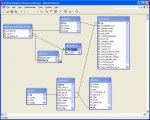Hi everyone,
Can anyone tell me please how I can insert a new record in a database if it has many tables linked with each other by primary/foreign keys ? Can I do it with one sql command or do I have to use the INSERT statement for every single table its linked to ?
Thank you
Can anyone tell me please how I can insert a new record in a database if it has many tables linked with each other by primary/foreign keys ? Can I do it with one sql command or do I have to use the INSERT statement for every single table its linked to ?
Thank you

